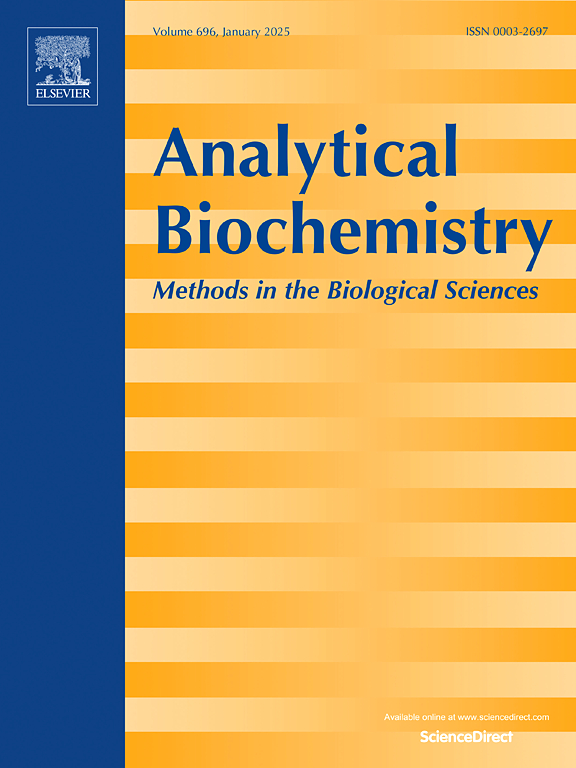基于新生布鲁氏菌脂多糖的竞争性酶联免疫吸附测定家畜布鲁氏菌病
IF 2.5
4区 生物学
Q2 BIOCHEMICAL RESEARCH METHODS
引用次数: 0
摘要
布鲁氏菌病是一种全球性的人畜共患病威胁,需要有效的诊断工具来进行有效监测。商业竞争性酶联免疫吸附试验(cELISA)主要利用从B. abortus和B. melitensis中提取的光滑脂多糖(S-LPS)作为布鲁氏菌病血清诊断的关键抗原。然而,培养病原体需要具有高生物安全性的设施,这在操作上是复杂的,并且在经济上要求很高。在本研究中,我们利用neotomae中提取的LPS制备了一种在生物安全二级条件下更容易处理的cELISA,并分析了cELISA的临床适应性。优化后的cELISA检测限较低,对melitensis和B. abortus血清的检测灵敏度是市售试剂盒的2 ~ 4倍。与其他细菌感染的血清,包括大肠杆菌、沙门氏菌、小肠结肠炎耶氏菌和结核分枝杆菌,未观察到交叉反应性。cELISA的诊断敏感性为100%(40/40),特异性为100%(40/40)。变异系数均小于10%。此外,与市售试剂盒相比,所开发的ELISA试剂盒对接种疫苗的427份牲畜血清的一致性为92.51%,对未接种疫苗的696份牲畜血清的一致性为96.98%。综上所述,cELISA具有良好的灵敏度、特异性和重复性,表明其在家畜布鲁氏菌病诊断中的潜力。本文章由计算机程序翻译,如有差异,请以英文原文为准。

Development of a competitive ELISA based on Brucella neotomae lipopolysaccharide for detecting brucellosis in livestock
Brucellosis, a global zoonotic threat, requires efficient diagnostic tools for effective surveillance. Commercial competitive enzyme-linked immunosorbent assay (cELISA) predominantly utilizes smooth lipopolysaccharides (S-LPS) extracted from B. abortus and B. melitensis as key antigens for brucellosis serodiagnosis. However, culturing pathogens requires facilities with high biosafety, which is operationally complex and economically demanding. In this study, we developed a cELISA using LPS extracted from B. neotomae, which can be handled more facilely in biosafety level 2 conditions, and analyzed clinical adaptability of the cELISA. The optimized cELISA demonstrated lower detection limits, which was 2–4 times more analytically sensitive than commercial kit by detecting sera against B. melitensis and B. abortus. No cross-reactivity was observed with sera infected with other bacteria, including E. coli, Salmonella, Y. enterocolitica, and M. tuberculosis. The diagnostic sensitivity and specificity of the cELISA were 100 % (40/40) and 100 % (40/40), respectively. The coefficients of variation were less than 10 %. Moreover, compared to the commercial kit, the developed ELISA achieved agreement of 92.51 % across 427 sera from vaccinated livestock, and agreement of 96.98 % across 696 sera from non-vaccinated livestock. In conclusion, the cELISA exhibits excellent sensitivity, specificity and repeatability, indicating its potential for brucellosis diagnosis in livestock.
求助全文
通过发布文献求助,成功后即可免费获取论文全文。
去求助
来源期刊

Analytical biochemistry
生物-分析化学
CiteScore
5.70
自引率
0.00%
发文量
283
审稿时长
44 days
期刊介绍:
The journal''s title Analytical Biochemistry: Methods in the Biological Sciences declares its broad scope: methods for the basic biological sciences that include biochemistry, molecular genetics, cell biology, proteomics, immunology, bioinformatics and wherever the frontiers of research take the field.
The emphasis is on methods from the strictly analytical to the more preparative that would include novel approaches to protein purification as well as improvements in cell and organ culture. The actual techniques are equally inclusive ranging from aptamers to zymology.
The journal has been particularly active in:
-Analytical techniques for biological molecules-
Aptamer selection and utilization-
Biosensors-
Chromatography-
Cloning, sequencing and mutagenesis-
Electrochemical methods-
Electrophoresis-
Enzyme characterization methods-
Immunological approaches-
Mass spectrometry of proteins and nucleic acids-
Metabolomics-
Nano level techniques-
Optical spectroscopy in all its forms.
The journal is reluctant to include most drug and strictly clinical studies as there are more suitable publication platforms for these types of papers.
 求助内容:
求助内容: 应助结果提醒方式:
应助结果提醒方式:


